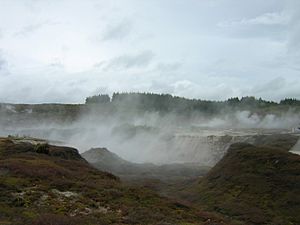Wairakei facts for kids
Quick facts for kids
Wairakei
|
|
|---|---|
|
Rural locality
|
|

The Craters of the Moon, a steamfield close by, created by the use of geothermal energy changing the underground pressure situation.
|
|
| Country | New Zealand |
| Region | Waikato region |
| District | Taupō District |
| Ward | Taupō East Rural Ward |
| Electorates |
|
| Area | |
| • Total | 0.36 km2 (0.14 sq mi) |
| Population
(June 2023)
|
|
| • Total | 550 |
| • Density | 1,530/km2 (3,960/sq mi) |
| Postcode(s) |
3332
|
Wairakei is a small village in the middle of New Zealand's North Island. It is about 8 kilometers (5 miles) north of Taupō. Wairakei is famous for its amazing geothermal features. You can find natural geysers, hot pools, and boiling mud pools here. It is also home to the Wairakei Power Station, which uses the Earth's heat to make electricity.
This area is part of the Taupō Volcanic Zone. This means there is a lot of heat and activity happening underground. The Wairakei Power Station was one of the first big geothermal power plants in the world. It started working in 1958. It was even featured in a book called 70 Wonders Of The Modern World!
Wairakei Village was built especially for the people who worked at the power station. It also housed workers from the nearby Aratiatia hydro power station. Since October 2022, buses have connected Wairakei to Taupō on weekdays.
Contents
Life in Wairakei Village
Wairakei Village is a small rural community. In 2018, about 507 people lived there. This was an increase from previous years. The village has about 132 homes. There are slightly more males than females living in Wairakei.
Who Lives Here?
The people in Wairakei Village come from different backgrounds. In 2018, about 68.6% were of European descent (Pākehā). About 47.9% identified as Māori. There were also people from Pacific Islands and Asian backgrounds. Some people identify with more than one ethnicity.
Most people in Wairakei Village (69.2%) said they had no religion. About 18.3% were Christian. A smaller number (3.6%) followed Māori religious beliefs.
Education and Work
For those aged 15 and older, a small number (5.9%) had a university degree. About 24.6% did not have formal qualifications. Many people in Wairakei Village work full-time (49.2%). Some work part-time (15.3%), and a few (10.2%) were unemployed in 2018.
Wairakei School
Wairakei School is a primary school for both boys and girls. It is a state school, meaning it is funded by the government. The school opened in 1959. It helps educate the children living in Wairakei and the surrounding areas.
Famous People from Wairakei
- Louise Rennison, a well-known author, lived in Wairakei when she was a teenager.
Wairakei Weather
Wairakei has a varied climate. The warmest months are usually January and February. The coldest months are July and August. It rains throughout the year, with December often being the wettest month. The weather can change, so it's good to be prepared!
| Climate data for Wairakei (1962–1987 normals, extremes 1952–1988) | |||||||||||||
|---|---|---|---|---|---|---|---|---|---|---|---|---|---|
| Month | Jan | Feb | Mar | Apr | May | Jun | Jul | Aug | Sep | Oct | Nov | Dec | Year |
| Record high °C (°F) | 32.9 (91.2) |
34.0 (93.2) |
30.0 (86.0) |
26.9 (80.4) |
21.2 (70.2) |
18.3 (64.9) |
17.8 (64.0) |
18.8 (65.8) |
23.0 (73.4) |
28.3 (82.9) |
28.0 (82.4) |
31.2 (88.2) |
34.0 (93.2) |
| Mean daily maximum °C (°F) | 23.5 (74.3) |
23.7 (74.7) |
21.7 (71.1) |
18.4 (65.1) |
14.4 (57.9) |
11.9 (53.4) |
11.4 (52.5) |
12.5 (54.5) |
14.3 (57.7) |
16.8 (62.2) |
19.2 (66.6) |
21.6 (70.9) |
17.5 (63.4) |
| Daily mean °C (°F) | 16.9 (62.4) |
16.9 (62.4) |
15.4 (59.7) |
12.2 (54.0) |
9.0 (48.2) |
6.8 (44.2) |
6.3 (43.3) |
7.3 (45.1) |
9.1 (48.4) |
11.2 (52.2) |
13.3 (55.9) |
15.5 (59.9) |
11.7 (53.0) |
| Mean daily minimum °C (°F) | 10.3 (50.5) |
10.2 (50.4) |
9.1 (48.4) |
6.1 (43.0) |
3.5 (38.3) |
1.9 (35.4) |
1.0 (33.8) |
2.1 (35.8) |
3.9 (39.0) |
5.6 (42.1) |
7.4 (45.3) |
9.3 (48.7) |
5.9 (42.6) |
| Record low °C (°F) | −0.5 (31.1) |
−1.1 (30.0) |
−2.6 (27.3) |
−6.4 (20.5) |
−5.9 (21.4) |
−6.8 (19.8) |
−7.0 (19.4) |
−7.1 (19.2) |
−6.6 (20.1) |
−4.6 (23.7) |
−3.2 (26.2) |
−1.5 (29.3) |
−7.1 (19.2) |
| Average rainfall mm (inches) | 83.3 (3.28) |
85.6 (3.37) |
98.0 (3.86) |
80.4 (3.17) |
99.5 (3.92) |
110.2 (4.34) |
118.2 (4.65) |
119.3 (4.70) |
111.4 (4.39) |
94.3 (3.71) |
93.2 (3.67) |
123.8 (4.87) |
1,217.2 (47.93) |
| Source: NIWA | |||||||||||||


